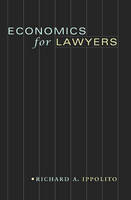
Economics for Lawyers
Princeton University Press (Verlag)
978-0-691-12177-2 (ISBN)
- Titel ist leider vergriffen;
keine Neuauflage - Artikel merken
Whether dealing with contracts, tort actions, or government regulations, lawyers are more likely to be successful if they are conversant in economics. "Economics for Lawyers" provides the essential tools to understand the economic basis of law. Through rigorous analysis illustrated with simple graphs and a wide range of legal examples, Richard Ippolito focuses on a few key concepts and shows how they play out in numerous applications.There are everyday problems: What is the social cost of legislation enforcing below-market prices, minimum wages, milk regulation, and noncompetitive pricing? Why are matinee movies cheaper than nighttime showings? And then there are broader questions: What is the patent system's role in the market for intellectual property rights? How does one think about externalities like airport noise? Is the free market, a regulated solution, or tort law the best way to deliver the "efficient amount of harm" in the workplace? What is the best approach to the question of economic compensation due to a person falsely imprisoned?
Along the way, readers learn what economists mean when they talk about sorting, signaling, reputational assets, lemons markets, moral hazard, and adverse selection. They will learn a new vocabulary and a whole new way of thinking about the world they live in, and will be more productive in their professions.
Richard A. Ippolito retired in 2004 as Professor of Law and Economics from the George Mason University School of Law, where he taught the materials that form the basis for this book to more than 1,000 law students over the course of his five-year tenure. He earned his Ph.D. in economics from the University of Chicago in 1974, and spent twenty-five years working with lawyers on policy and regulatory issues. His previous books include "Pension Plans" and "Employee Performance".
Introduction xv What Makes This Book Different xvii Recommended Supplementary Reading xviii Chapter 1: Finding the Optimal Use of a Limited Income 1 I. INDIFFERENCE CURVES 1 A. The Main Question 1 B. Indifference Curves Slope Downward 2 C. Other Things to Know about Indifference Curves 4 II. GAINS FROM TRADE USING THE EDGEWORTH BOX DIAGRAM 6 A. Construction of the Box 8 B. Pareto Superior Trades 10 C. The Contract Curve: Pareto Optimal Allocations 12 III. THE BUDGET LINE: THE ESSENCE OF THE ECONOMIC PROBLEM 14 A. Impact of Income Changes 16 B. Impact of Price Changes 16 IV. CONSUMER CHOICE: THE OPTIMUM USE OF A LIMITED INCOME 16 A. Determining the Optimal Solution 16 B. Portraying an Exact Solution 18 C. How a Change in Income Affects Choice 19 D. The Impact of a Price Change on the Optimum Solution 20 V. THE COMPENSATION PRINCIPLE: THE DOLLAR VALUE OF CHANGES IN UTILITY 20 A. Valuing the Utility Change from a Price Reduction 20 B. Anatomy of a Price Change: Income and "Price" Effects 23 VI. APPLICATIONS OF THE COMPENSATION PRINCIPLE 24 A. Buckley's Tulips and Mums Problem 24 B. Dominic's Report Card and Computer Games 33 Chapter 2: Demand Curves and Consumer Surplus 41 I. FROM INDIFFERENCE CURVES TO DEMAND CURVE 41 II. CONSUMER SURPLUS 46 A. An Intuitive Way to Understand Consumer Surplus 47 B. Using the Compensation Principle 49 C. Checking Back with the Indifference Curve Map 51 III. MARKET DEMAND CURVE 52 A. Consumer Surplus When Demand Curves Are Linear 55 B. Complements and Substitutes 57 C. Changes in Income 59 IV. DEMAND ELASTICITY 59 A. Calculating the Elasticity for a Linear Demand Curve 60 B. Relation of Elasticity to Total Revenue 63 C. Long-run versus Short-run Elasticity 67 V. APPLICATION: IMPOSITION OF A TAX 68 A. Showing the Distortion on Indifference Curves 68 B. Efficiency in a Kaldor-Hicks Sense 70 C. Showing the Distortion on the Demand Curve 73 D. Tax Burden: Application of Demand Elasticity 76 APPENDIX: CONSUMER SURPLUS AND UNCOMPENSATED DEMAND CURVES 80 Chapter 3: Supply Curves and the Flow of Resources Also Sunk Cost, Opportunity Cost, and Transactions Cost 82 I. THE WORLD MARKET FOR NICKEL 83 A. The Supply of Nickel with No Fixed Costs 83 B. Producer Surplus 85 C. The World Price for Nickel 86 D. Surpluses in Market Equilibrium 88 II. THE SOLUTION WITH FIXED COSTS AND MANY FIRMS 89 A. Constructing the Cost Curves 90 B. Sustainable Price: Equilibrium in a Long-run Sense 94 III. MARKET EQUILIBRIUM: ENTRY, EXIT, AND COMPETITIVE RETURNS 95 A. How to Evaluate the Sustainability of a Market Price 95 B. The Dynamics of Entry 96 C. The Concept of Long-run Supply 99 IV. PRODUCER SURPLUS, LONG AND SHORT RUN, AND ECONOMIC RENT 100 A. Producer Surplus in a Short-run Sense 100 B. The Concept of "Rent" 101 C. The Dynamics of an Increase in Rent 103 D. Portraying the Solution in the Market for Litigation Services 104 E. The Long-run Supply Curve 107 V. BRINGING IT ALL TOGETHER: RECONSIDERING A TAX ON ONE GOOD 111 A. Short-run Impact of the Tax 111 B. Long-run Impact of the Tax 113 VI. A FEW MISCELLANEOUS COST ISSUES 115 A. Sunk Cost 115 B. Opportunity Cost 120 C. Transactions Cost 122 APPENDIX: SHORT- AND LONG-TERM IMPACT OF A SUBSIDY 125 Chapter 4: Using Demand and Supply Curves to Evaluate Policy 127 I. SHIFTS IN DEMAND AND SUPPLY CURVES 128 II. IMPACT OF A MAXIMUM PRICE: THE CASE OF GASOLINE 131 A. Setting Up the Problem 131 B. The Queue for Gasoline 133 C. The Social Cost of the Queue 135 D. A First Lesson in Property Rights 137 E. A Candidate for an Even More Inefficient Solution: Regulation 139 III. THE ECONOMICS OF THE MINIMUM WAGE 140 A. Unskilled Workers Still Employed Gain Rent 141 B. Some Low-rent Workers Displace Some High-rent Workers 142 C. High-rent Workers Outhustle Low-rent Workers 143 D. Rent to Unskilled Workers 146 E. Effort Adds Value, Which Attenuates Job Losses 147 F. A Note on Unions 148 IV. PRICE SUPPORTS 148 A. Restriction on Output 149 B. No Restriction on Supply 151 Chapter 5: The Economics of Monopoly 153 I. THE PRICE DECISION 154 A. The Rule for Finding the Profit-maximizing Price 154 B. Finding the Optimal Price 156 C. Characteristics of the Monopoly Solution 159 II. THE SOCIAL COST OF MONOPOLY 161 A. Deadweight Loss 161 B. Market for Monopoly 163 C. Rent Erosion 164 III. MONOPOLY PRICE DISCRIMINATION 170 A. Two Markets: Ice Cream Monopoly 170 B. Perfect Price Discrimination 173 C. Other Ways to Extract Consumer Surplus 174 IV. PRICE DISCRIMINATION IN COMPETITIVE MARKETS 176 A. Movie Theaters 176 B. Other Examples 180 V. COMPETITION OF THE FEW 183 A. Cheating 184 B. Prisoner's Dilemma 185 APPENDIX A: PRICE DISCRIMINATION IN THE MILK MARKET 188 A. How Milk Regulations Work 188 B. The Social Cost of Regulation 191 APPENDIX B: THE MOVIE THEATER COST STRUCTURE 193 Chapter 6: Public Goods and Common Resources Toward Understanding the Economics of Property Rights 194 I. AN INTRODUCTION TO PUBLIC GOODS 195 II. INNOVATIONS: CLASSIC PUBLIC GOODS 199 A. The Solution in an Ideal World 200 B. Patent Awards 203 C. How the Patent System Affects Societal Surplus 204 D. The Patent Quandary 208 E. Other Ideas about Patents 212 III. CONTRACTS UNDER DURESS: THE COMMON RESOURCE PROBLEM 214 A. Honor the Contract 216 B. Nullify the Contract and Impose a Reasonable Settlement 217 C. The Optimal Settlement Rule 217 D. The Main Problem: Setting Average Value to Marginal Cost 220 E. Another Way to Think about the Problem 221 IV. THE SOURCE OF RENT EROSION: POORLY DEFINED PROPERTY RIGHTS 222 Chapter 7: Externalities The Coase Theorem 228 I. WHY EXTERNALITY ISSUES ARE DIFFERENT 228 II. AIRPORT NOISE 230 A. Setting Up an Externality Model 230 B. There Is No Costless Solution to an Externality Problem 233 C. The Socially Optimum Level of Externality 234 III. THE COASE THEOREM 235 A. Airlines Own Noise Rights 235 B. Homeowners Own Noise Rights 236 C. What If Transactions Costs Are Not Zero? 237 D. Corrective Taxes 240 IV. ALLOWING FOR NOISE ABATEMENT 241 A. Stylized Abatement Technology 242 B. A Corrective Tax with Abatement 244 C. Coase with Abatement 245 D. Tradable Noise Permits 245 E. What If Homeowners Can Abate Some Noise? 246 Chapter 8: Pollution in the Workplace: Contract or Externality? An Introduction to the Rules of Law 247 I. COMPENSATION FOR EXPOSURE TO AIR PARTICULATES 248 A. Setting Up the Air Particulate Problem 249 B. The Demand for Clean Air 249 C. The Supply of Clean Air 250 D. The Socially Optimal Amount of Clean Air 251 II. HOW DO WE OBTAIN THE SOCIALLY EFFICIENT SOLUTION? 251 A. A Contract Solution (Buyer Beware) 251 B. Regulatory Solution 252 C. Strict Liability Standard 253 III. THE COMPENSATION PRINCIPLE AND ECONOMIC DAMAGES 254 A. Torts Are the Flip Side of Contracts 255 B. What If Judgment Amounts Are Not Economic Damages? 258 C. Transactions Costs Again 260 D. Value of Life in a Contract Setting 261 E. Value of Life in a Liability Setting 262 IV. NEGLIGENCE STANDARDS 267 A. An Efficient Negligence Standard 267 B. What If Workers Can Reduce Harm Themselves? 268 C. Contributory Negligence 269 D. Comparative Negligence 269 E. Strict Liability with Contributory Negligence 270 APPENDIX A: THE DECISION TO SMOKE AND RULES OF LAW 272 APPENDIX B: DRIVING AND ACCIDENTS 276 APPENDIX C: ABATEMENT WITH MASKS 280 Chapter 9: Lemons Markets and Adverse Selection Signals, Bonds, Reputation, and Tie-ins as Solutions 282 I. THE "LEMONS" MARKET PROBLEM 284 A. How a "Lemons" Market Arises 284 B. A Market for Information 287 II. BONDING A PROMISE OF HIGH QUALITY 288 A. Reputation Value 289 B. Quality Assurance Premium: Where Does Reputation Value Come From? 290 C. Specialized Investments 293 D. Advertising 295 E. Warranties 297 III. PROBLEMS WHEN THE SELLER IS UNINFORMED: ADVERSE SELECTION 299 A. Temporal Adverse Selection 300 B. Cross-section Adverse Selection 302 C. Some Market Solutions 305 D. A "Tie-in" Contract 307 E. The Employment Contract as a Tie-in 308 IV. ADVERSE SELECTION IN THE JOB MARKET 313 APPENDIX: AUCTIONS AS APPLICATIONS OF DEMAND THEORY AND BONDING 316 Chapter 10: Sorting as a Solution to Asymmetric Information Coaxing Market Participants to Divulge Valuable Information 321 I. BONDS THAT ALSO PERFORM SORTING: THE BECKER-STIGLER POLICE MODEL 324 A. A Becker-Stigler Pension Bond 324 B. An Indenture Premium 328 C. How Does the Bond Create a Sort? 328 D. An Alternative Bond: An Efficiency Wage 330 E. Putting the Two Bonds Together 332 II. THE SPENCE MODEL OF SORTING 334 A. The Idea in Brief 334 B. Application to Law School 335 C. Pursuing the Model One Step Further 335 III. OTHER SORTING DEVICES IN THE LABOR MARKET 336 A. The Not-so-free Free Sick Leave 336 B. Sorting on the Basis of Discount Rates 338 C. 401(k) Pension Plans: Another Sort on the Basis of Discount Rates 341 D. A Postscript on Becker-Stigler: Role of High Discounters 342 IV. MORE EXAMPLES OF SORTS AND BONDS 344 A. Slotting Allowances 344 B. Preparing for a Job Interview 345 Chapter 11: Moral Hazard and Agency Problems When Mispricing Affects Behavior 348 I. NOMENCLATURE 349 II. MORAL HAZARD 350 A. A Simple Water Meter Example 351 B. The Moral Hazard of Insurance 351 C. The Proverbial Free Lunch 354 D. Limits on Moral Hazard 356 E. Moral Hazard Is Not Necessarily a "Showstopper" 360 III. PRECOMMITMENT AS A SOLUTION TO EX POST MORAL HAZARD: THE CASE OF HEALTH INSURANCE 362 A. The Moral Hazard Problem 362 B. Consumer Surplus 364 C. Contracting for Efficient Care 366 D. What Happens If the ERISA Preemption Is Eliminated 367 IV. AGENCY COST: A CLOSE COUSIN TO MORAL HAZARD 369 A. What Are Agency Costs? 369 B. Examples of Agency Costs 369 V. AGENCY COSTS AND RENT EROSION: THE CASE OF TORT LAWYERS 375 A. The Reimbursement System 375 B. The Principal-Agent Problem 375 C. Implications of Rent Erosion 377 Chapter 12: Game Theory and Related Issues Strategic Thinking When Players Are Few and Information Is Poor 380 I. THE DATING GAME: BASIC CONCEPTS IN GAME THEORY 381 A. How the Game Works 381 B. Outcomes with Different Payoffs 385 C. Where Is Coase? The Role of the Cooperative Solution 389 II. BEYOND THE DATING GAME: OTHER PRACTICAL APPLICATIONS 389 A. Games in the Hiring Process 390 B. Irrational Behavior: What If Signals Are Crossed? 393 C. Dick Gets Mugged in the Park 395 III. INSTITUTIONS AND COOPERATIVE OUTCOMES 397 A. The Prisoner's Dilemma Reconsidered 397 B. Solving the Common Resource Problem: Holdups in the Building Trades 398 C. Solving the Public Goods Collection Problem: Protection for the Neighborhood 400 V. HOW LEGAL STANDARDS CHANGE THE PAYOFFS 401 A. Drivers and Cyclists 401 B. A Noise Problem 403 V. APPLICATIONS TO QUASI-MONOPOLY MARKETS: SOME SIMPLE GAME THEORY MODELS 407 A. The Cournot Model 408 B. Sequential Decision: Stackelberg 411 C. A Tit-for-tat Strategy 413 B. Index 417
| Erscheint lt. Verlag | 1.5.2005 |
|---|---|
| Zusatzinfo | 94 line illus. 29 tables. |
| Verlagsort | New Jersey |
| Sprache | englisch |
| Maße | 152 x 235 mm |
| Gewicht | 482 g |
| Themenwelt | Recht / Steuern ► EU / Internationales Recht |
| Recht / Steuern ► Privatrecht / Bürgerliches Recht ► Berufs-/Gebührenrecht | |
| Wirtschaft ► Volkswirtschaftslehre | |
| ISBN-10 | 0-691-12177-X / 069112177X |
| ISBN-13 | 978-0-691-12177-2 / 9780691121772 |
| Zustand | Neuware |
| Informationen gemäß Produktsicherheitsverordnung (GPSR) | |
| Haben Sie eine Frage zum Produkt? |
aus dem Bereich


